Chimney Rock at Point Reyes National Seashore is an easy hike where you can see a wide variety of wildflowers. There are many that are found only in California (endemic), and several that are listed as rare and endangered by the California Native Plant Society. There is an interesting lighthouse nearby (with more wildflowers!), and if you go at the right time of the year you can see Elephant Seals.
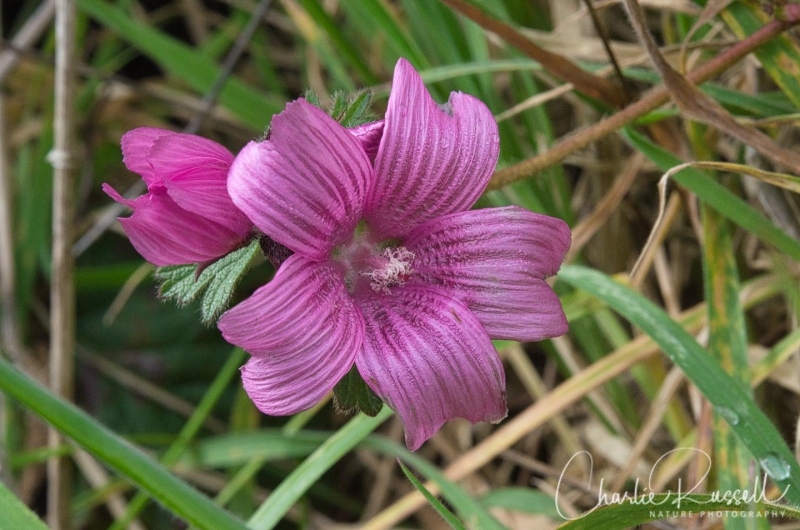
The Hike
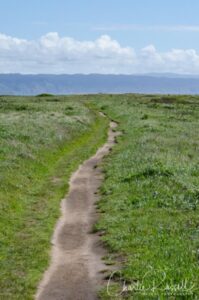
The trail from the parking lot to the end of the trail is not quite a mile long. It is an easy trail, although it isn’t wheelchair accessible. Be careful near the cliffs, and stay on the trail. The main issue here is the wind – this is a very windy and exposed area. Check the weather forecast before heading out there, if you want to take flower pictures.
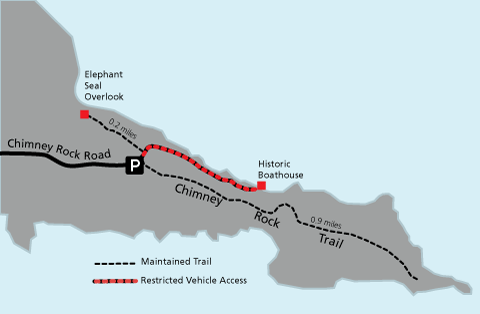
There are wildflowers all along the trail, so keep your eyes open. Note that the sign at the beginning of the trail isn’t totally accurate, a few of the plants that it shows are mislabeled (it was updated in 2022, but it still isn’t totally accurate). At the very end of the trail there is a little loop, with one side dipping down behind the headland. This tends to be protected somewhat from the wind, and it is a good place to look for wildflowers that you might not see in other places, such as the Coastal Larkspur.
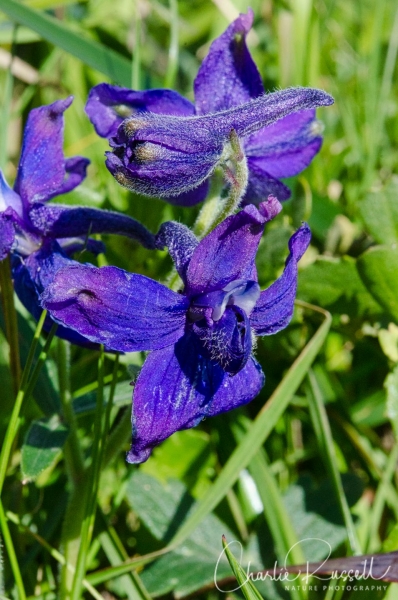
Directions
Chimney Rock is located at the eastern end of the Point Reyes Headlands. Allow 45 minutes for the drive from the Bear Valley Visitor Center. I recommend visiting the Point Reyes National Seashore website and downloading a park map.
- From the Bear Valley Visitor Center, head north 0.2 miles (0.3 km) to Bear Valley Road.
- Turn left and follow Bear Valley Road 1.75 miles (2.8 km) northwest to Sir Francis Drake Boulevard.
- Turn left and follow Sir Francis Drake Boulevard 17.6 miles (28.2 km) west to Chimney Rock Road, just south of the Historic “A” Ranch. Tip: Follow road signs for “Lighthouse” until you see a sign for Chimney Rock.
- Turn left and follow Chimney Rock Road 0.9 miles (1.5 km) east to the Chimney Rock Trailhead. Please drive slowly and carefully along this one-lane wide road.
Parking is limited, and it can be very crowded on weekends. At the height of the elephant seal season the National Park Service will close the road leading up to this area on weekends, and run a shuttle bus from the South Beach area.
If you visit Chimney Rock from late December through mid-April, I recommend walking to the elephant seal beach overlook. You can’t get down to the beach due to the elephant seals. I have some pictures in the gallery of the seals from this visit. There also are many wildflowers along this path in the spring.
I also recommend visiting the lighthouse that is at the end of the road, past Chimney Rock. Again, the parking lot can be really crowded, even on weekdays. If you go here, at the parking lot immediately to your left as you face the path to the lighthouse, there is a small trail up onto the rocks. Lots of wildflowers to see up there!
Timing is Everything
This visit was on a clear (but windy) day in late March. I’ve also visited this area later in April in other years. Depending on the weather, you should be able to find wildflowers of some sort from early March through possibly as late as May.
Chimney Rock Wildflowers
Here’s a sample of a few of my favorites from this hike. Please feel free to correct any errors I may make.
Douglas Iris are plentiful along the trail at the top of the headland. These tend to show up late March into early April.
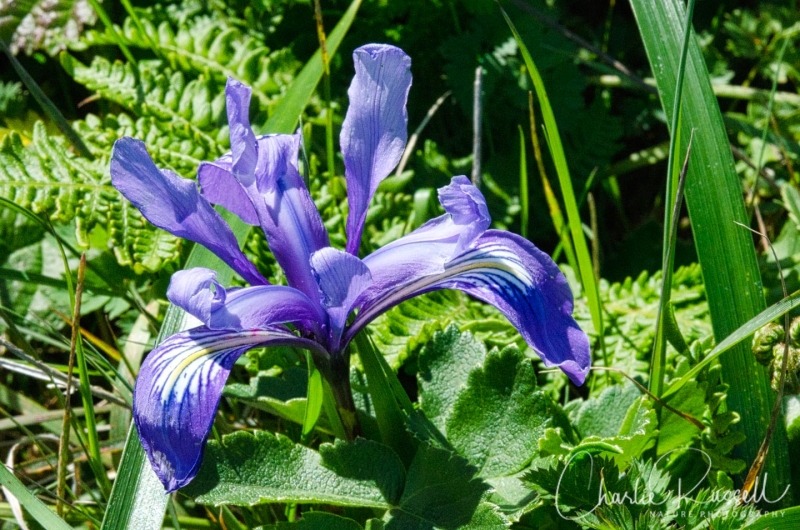
San Francisco Owl’s Clover is listed as a rare/endangered plant by CNPS (California Native Plant Society). It is found only in California. This one is mislabeled on the sign at the trailhead.
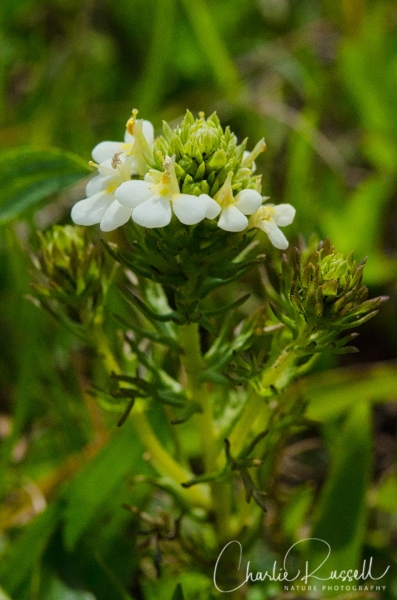
Headland Wallflower is another plant on the CNPS rare/endangered list. These were found at the very end of the trail.

Perennial Goldfields is much larger than the typical small vernal pool Goldfields that I’m used to. These flowers are several inches across. I found these at the lighthouse. It also is listed as rare/endangered by CNPS.
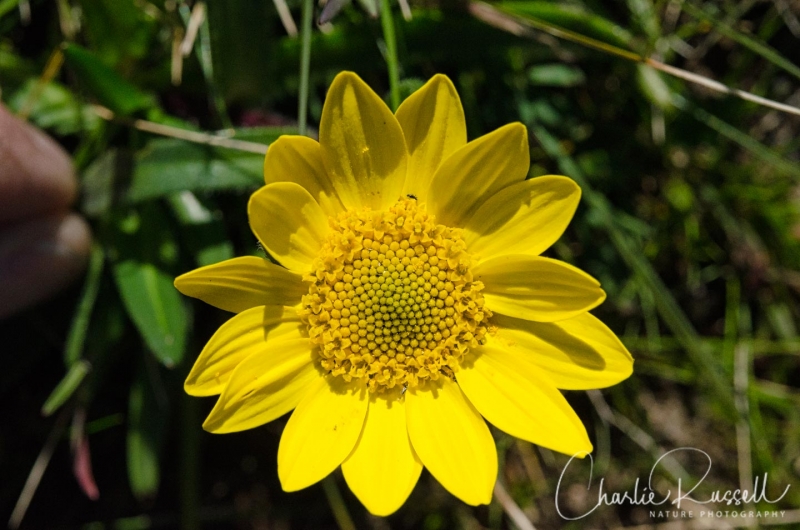
For the best viewing experience, click on the lightbox image below, and you can scroll through larger versions of the photos of many of the plants that we found on this hike. All photos are available for purchase in a variety of formats. Many of these are from the Chimney Rock trail, a few are from the Elephant Seal trail that is nearby, and others are from the area around the lighthouse.
Here’s a listing of what I found on this visit:
- Baby blue eyes (Nemophila menziesii var. atomaria)
- Baby blue eyes (Nemophila menziesii var. menziesii)
- Beach strawberry (Fragaria chiloensis)
- Blue violet (aka Western dog violet, Viola adunca)
- California blackberry (Rubus ursinus)
- California buttercup (Ranunculus californicus)
- California goldfields (Lasthenia californica)
- California man-root (Marah fabacea)
- California phacelia (Phacelia californica)
- California poppy (Eschscholzia californica)
- California sea pink (Armeria maritima ssp. californica)
- Checkerbloom (Sidalcea malviflora ssp. malviflora)
- Coast indian paintbrush (Castilleja affinis ssp. affinis)
- Coastal bush lupine (Lupinus arboreus)
- Coastal gumplant (Grindelia stricta var. platyphylla)
- Coastal larkspur (Delphinium decorum ssp. decorum)
- Common cowparsnip (Heracleum maximum)
- Douglas iris (Iris douglasiana)
- Field chickweed (Cerastium arvense)
- Footsteps of spring (Sanicula arctopoides)
- Headland wallflower (Erysimum concinnum) CNPS 1B.2
- Hillside pea (Lathyrus vestitus var. vestitus)
- Manycolored lupine (Lupinus varicolor )
- Miner’s lettuce (Claytonia perfoliata ssp. perfoliata)
- Narrow leaf mule ears (Wyethia angustifolia)
- Perennial goldfields (Lasthenia californica ssp. macrantha) CNPS 1B.2
- Red maids (Calandrinia menziesii)
- Rough hedgenettle (Stachys rigida var. quercetorum)
- San Francisco owl’s clover (Triphysaria floribunda) CNPS 1B.2
- Seaside daisy (Erigeron glaucus)
- Seaside fiddleneck (Amsinckia spectabilis var. spectabilis)
- Sun cup (Taraxia ovata)
- Western blue eyed grass (Sisyrinchium bellum)
- Wight’s paintbrush (Castilleja wightii)
- Woolly fruited lomatium (Lomatium dasycarpum ssp. dasycarpum)
The following are non-native plants that we found on the hike as well:
- Corn spurry (Spergula arvensis)
- Pale flax (Linum bienne)
- Red stemmed filaree (Erodium cicutarium)
- Rosy sandcrocus (Romulea rosea)
- Scarlet pimpernel (Lysimachia arvensis)
- Shepherd’s needle (Scandix pecten-veneris)



























































0 Responses
Hi Charlie, Thank you for capturing the details. I had a quick question: did you see any meadows at Chimney Rock or is it too early for that?
Chimney Rock is a rugged headland area, there isn’t a meadow there in the traditional sense. The top of the ridge has a broad flat area, but it really isn’t a meadow. Off to the north there are some grassland hikes that I hope to get posted later this year, and several beach areas. But I don’t consider these to be true “meadows”. I guess it depends on your interpretation of the term.
Hi Charlie,
Do you know if there are still wildflowers blooming near Point Reyes lighthouse? And what conditions they may be in.
Thanks
Yung
I’m sorry, I haven’t been out there in awhile, so I can’t say. You might call the park HQ to see what they say, although they aren’t always knowledgeable about flowers. Abbots Lagoon, which isn’t too far away, most likely has some good flowers. I’m seeing reports about the dunes there, and there is a hilltop to the south when the trail gets to the beach that can be quite interesting.